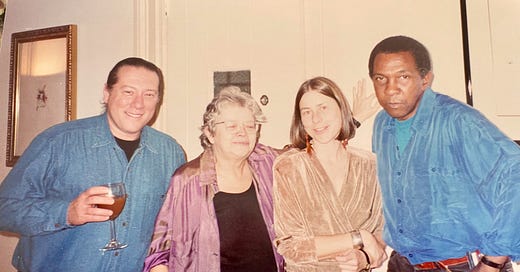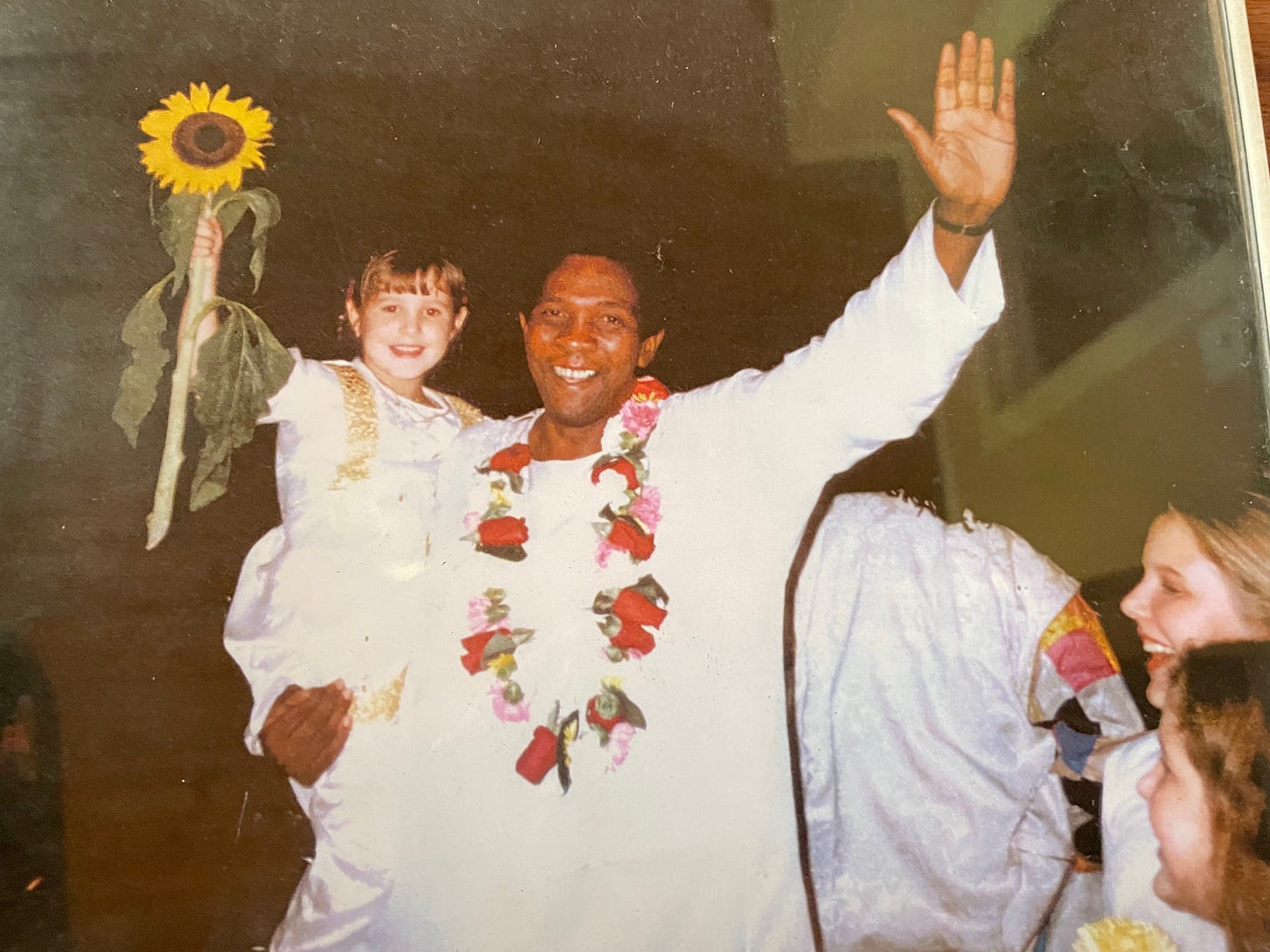Carman Moore - Big Brother, Best Man - #12
It began one night at The Cathedral of St John the Divine
This most recent New Yearʻs Eve my big brother and best man Carman Moore called from New York City to wish me a Happy New Year before heading out for the eveningʻs festivities. Hi Precious, began the voicemail message I quickly returned. As we chatted, I told Carman it was time for me to write about him in my memoir, but I could not pin down the dates of the program at the Cathedral of St John the Divine where we met. Was it late 1992 or early 1993?
Carman thought for a moment and chuckled. “Somewhere in there.” He thought for another moment, trying for another point of reference, and asked, “Were you with us when we went to Mt Shasta for Velvaleeʻs ascension?” “No,” I answered, “I didnʻt meet Velvalee until she came to New York for the Mass in 1994.” “Thatʻs right,” he said, “Billielee was there, and Michiyo, and Eckart Tolle but he wasnʻt famous yet, he was just Velvaleeʻs friend.” We were silent for another moment, lost in shared memories across the 5,000 miles separating us. Then we just started laughing. And laughing. “No one would believe the stories. It sounds like fiction,” Carman finally caught his breath and continued. “Thatʻs why I have to write them!” I concluded.
Around 1994 - from left, documentary filmmaker Steve Levitt; Amelia Toledo, my Brazilian “mother” and groundbreaking artist; me; big brother best man Carman Moore gathered in my apartment at 16 St Lukes Place.
So letʻs call it late 1992. Having returned from traveling to Tibet with World Wheel artist Vijali, and started commuting to Brazil where my social circle included many artists (these facts fulfilling three of my Four Things I Always Wanted to Do), I was drawn to a weekend conference at the Cathedral of St John the Divine on The Sacred in the Arts. It began on a Friday night with a dinner and speaker, followed by a concert of excerpts from a work in progress called The Mass for the 21st Century being composed by an artist-in-residence at the Cathedral.
It had been a hard week at work and I was tired, really tired, by that Friday evening. My plan was to cut out after dinner to be fresh for the Saturday morning sessions. But despite my protests about the high probability I would embarrass them by falling asleep during the concert, my table mates persuaded me to join them in the chapel. I need not have worried.
On stage stood a tall, elegant man with closely cropped hair and skin the color of dark chocolate, ready to conduct an ensemble of two keyboards and a grand piano, a saxophone/flute player, violinist, drummer, small choir – plus a Tibetan flute player and a Senegalese griot. Hmmm. The lights went down and the music began. Almost immediately I was on the edge of my seat in excitement. The musicianship! Clearly classically trained, but with a capacity to improvise like a jazz ensemble. The music! Classical crossover is a term that until then I had viewed with suspicion. But this music was genius, putting fresh life into the classical form of the Mass. The lyrics tugged at my poetʻs heart.
I grabbed my program, trying to read in the dark. Who was this composer/conductor Carman Moore? What was this work in progress? From what I could figure out, the man on stage knew what he wanted to be doing in seven years, on New Yearʻs Eve as the Year 2000 arrived – and he intended to take a message of peace and hope for the new millennium around the world in the meantime.
Then came a moment that divided my lifeline into before and after, a moment in which I simply fell in love. Musically, at least. For those who might not be familiar with the classical form of a Mass, it sets the required components of the Catholic/Anglican liturgy to music. Carmanʻs Allelujah begins with a childrenʻs chorus sweetly singing about their place in Natureʻs Plan. Finally the adults join in:
LET NATURE'S WAY INSTRUCT US EVERY DAY
THE CREATOR'S PLAN BE THE LAW IN EVERY LAND
LET THE RAIN RAIN RAIN ON THE FOREST AND THE PLAIN
LET THE EAGLE SOAR, LET THE OCEAN ROAR
LET THE EARTH RESTORE AND LET US STUDY WAR NO MORE
There is a pause, the smallest moment of silent anticipation. The rhythm section kicks back in. And suddenly Carman takes us from something hinting at polyphonic modal counterpoint Renaissance church music to a full on rocking gospel choir. AMEN!
Carman Moore and members of the childrenʻs choir following performance of The Mass for the 21st Century in its debut at Lincoln Center Out-of-Doors.
The next day I sought Carman out to tell him how moved I was by his music and vision. I told him I was working on Wall Street, currently going back and forth to Brazil each month but with connections around the globe, and would like to help him take the Mass for the 21st Century on the road when it was ready. He shared that he had a commissioned performance at Lincoln Center Out of Doors for the summer of 1994, and that would be the first full multimedia staging. We exchanged contact information and Carman invited me to come meet some of his SkyMusic Ensemble musicians and other collaborators at his apartment on Columbus Circle.
Resume-wise, there is a lot I could say about my trailblazing big brother. After getting a Bachelor of Music degree in his native Ohio, Carman came to NYC for his masters in composition at Julliard. He still occupies his first walkup apartment equidistant from Lincoln Center and Central Park, where he walks daily and knows every tree, bird, and landmark as his friend. Although he is modest about it all, I saw doodles by John Lennon in the margins of an early score. I found a newspaper clipping describing the premieres of his first two symphonies thirty years prior to our meeting. First Carman flew to San Francisco for the premiere of Gospel Fuse by the San Francisco Symphony with Seiji Ozawa conducting and Cissy Houston as soloist – a work he described as a “22-minute atomic age gospel cantata.” Then he took a redeye back to New York where the Philharmonic played Wildfires and Field Songs, commissioned by conductor Pierre Boulez. There was also something about Carman and his then wife attending with Robert Redford and his then wife – I donʻt think I invented that story.
Carman has written pop songs, opera, musicals, film scores, dance scores, meditations, and plenty of music that simply refuses to be categorized by genre. His collaborating musicians, dancers and writers are brilliant, accomplished, fiercely loyal to him, and to a person incredible human beings full of heart and soul.
Did you ever trace the genealogy of your friendships? The most important single chain of enduring friendships and chosen family relationships in my life starts with that conversation between me and Carman Moore at the Cathedral of St John the Divine thirty years ago. Some of those stories will be told in these pages, which is why it was time to bring Carman into the storyline.
Why do I call him my “Big Brother Best Man”? Carman adopted me from the start and has played the role of big brother to me for three decades. For a while I tried to manage his unmanageable artistic career, a story I might get to if I write into the late 1990s. I have mused and applauded and produced and even occasionally been the grateful recipient of various compositions. We have encouraged each other unconditionally in our adventures and aspirations, seen each other in and out of romantic relationships, traveled together, hosted memorable parties and gatherings in our homes, cried at funerals and planned a wedding (mine) at which he was actually best man. Besides, as a human being, Carman Moore absolutely qualifies as among the very best of men.





